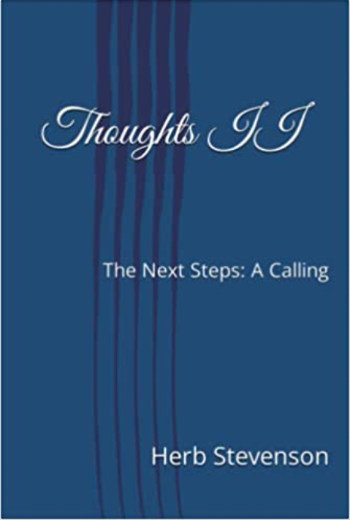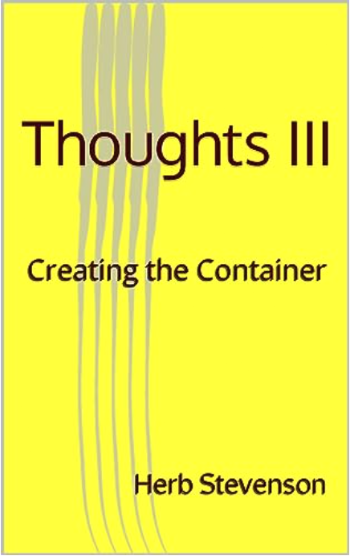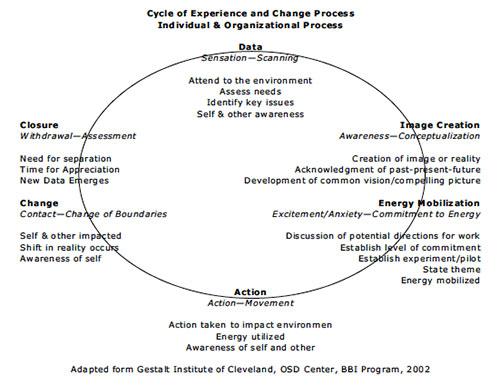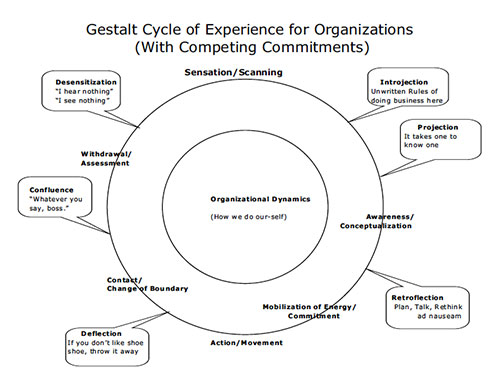

A book by Herb Stevenson, Volume 1. Learn more on Amazon.
Thoughts II:
The Next Step: A Calling

Volume 2 of 3. Learn more on Amazon.
Thoughts III:
Creating The Container

Volume 3 of 3. Learn more on Amazon.
To Lead
Read the article about training with Herb Stevenson in ALN Magazine.
See the article...
Gestalt Cycle of Experience
by Herb Stevenson
Background
In 1947, Perls introduced what would become the cycle of experience. He called it Organismic/World Metabolism as a description of the process underlying the achievement of internal balance. He believed that there exists an instinctive cycle which reflected the “cycle of the interdependency of organism and environment.” (Perls, 1969, 44; 69)
This cycle was a self-regulating experiential cycle that maintained the internal equilibrium of each individual. Because self regulation for human beings involves some form of consciousness that includes moral regulation, the moral regulation, by it’s very nature, “must lead to the accumulation of unfinished situations in our system and to interruption of the organismic circle. (Perls, 1969, 45) Hence, we have an instinctual cycle that seeks to complete itself. However, through internal and/or outside influences, the completion of this cycle can be short-circuited, creating an incomplete cycle. This incomplete cycle, if necessary to return the organism to equilibrium, will continue to recycle until the original need is satisfied. Such situations result “in a ‘fixed Gestalt’ or ‘unfinished experience/situation’ which interferes with good contact with self, others, or the environment in the present.” (Clarkson, 2000, 7)
Cycle of the interdependency of organism and environment
| Cycle of Interdependency | Internal Disturbance Cycle | External Disturbance Cycle |
1) The organism at rest. 2) The disturbing factor, which may be a) An external disturber—a demand made upon us, or any interference that puts us on the defensive. b) An internal disturbance—a need which has gathered enough momentum to strive for gratification and which requires 3) The creation of an image or reality (plus-minus function and figure-background phenomena). 4) The answer to the situation aiming at 5) A decrease of tension—achievement of gratification or compliance with the demands resulting in 6) The return of the organismic balance. |
1) I am dozing on a coach. 2) The wish to read something interesting penetrates my consciousness. 3) I remember a certain book-shop. 4) I go there and buy a book. 5) I am reading. 6) I have had enough. I set the book aside. |
1) I am lying on a couch. 2) A fly is crawling over my face. 3) I become aware of the disturber. 4) I get annoyed and fetch a swatter. 5) I kill the fly. 6) I go back to the couch. |
Adapted from (Perls, 1969, 44-45)
The Cycle of Awareness
In the 1970's, the thinking by Bill Warner, Miriam Polster and Joseph Zinker at the Gestalt Institute of Cleveland expanded gestalt theory with the formulation of the contact cycle and then the awareness-excitement-contact cycle. In basic terms, the cycle evolved from trying to explain how contact occurred. Initially, it was believed that contact moves through eight stages:
- 1) the emergence of need;
- 2) the attempt to play out the need;
- 3) the mobilization of the internal struggle;
- 4) statement of theme incorporating the need and the resistance;
- 5) the arrival of the impasse;
- 6) the climatic experience;
- 7) the illumination; and the
- 8) acknowledgment.
(Polster & Polster, 1973, 176)
It was noted that the contact cycle was not time-bound, as the cycle may last only a moment, a minute, an hour, a year, or even a lifetime. The eight stages could occur in different sequences or sometimes condensed into simultaneity. Moreover, it was noted that the sequence of the cycle was a guideline and “not to be taken as a cut and dried order.” (176)
Cycle of Awareness-Excitement-Contact
The cycle evolved as creative applications were tried. Zinker diagramed the creative process as a cycle of experience for the individual. He took the figure/ground concept developed by Perls, Hefferline & Goodman combined with the contact cycle of the Polsters and described experience in the following sequence:
- 1) sensation
- 2) awareness
- 3) mobilization of energy
- 4) action
- 5) contact
- 6) withdrawal/satisfaction.
(Zinker, 1977, 11)
The power of this description is that it gave greater depth and understanding to figure/ground formation. The figure would surface during sensation, where the individual experiences something happening that disturbs the steady state. If the sensation holds sufficient attention of the individual, awareness of a need would sharpen. Awareness begins to develop through a mixture of feelings, thoughts, perceptions that seek to interpret the sensation. Energy mobilizes in response to this awareness of a specific need that is seeking satisfaction. The energy is released and Contact is made with that which will satisfy the need. During contact, whatever is other than the self is digested by destructuring to find what is new or different and assimilating (or integrating) it. When what is new or different has been satisfactorily destructured and assimilated, change occurs within the organism (individual). Once the original need has been satisfied, the individual returns to a steady state by withdrawing from the experience and closing the cycle. When the cycle has been completed, the individual would return to sensation and wait for a new figure to emerge from the fertile ground of the individual. (Zinker, 1977, 90-91)
Noteworthy is that this reformulation of figure/ground helped to conceptualize the internal processes occurring within each individual at any given moment in time. Moreover, it created a vehicle to understand how the individual could interrupt his or her own process. In other words, a break in the cycle of experience would be a break in the movement toward satisfaction. Discover how the individual or the environment habitually interrupts this cycle of experience and the individual would discover “unfinished business” from the past. More importantly, the individual would be able to learn how to interrupt the interruptions so that the cycle could move toward completion and the satisfaction of the original figural need.
Group Cycle of Experience
In 1980, Zinker continued to develop the cycle of experience. He applied it to groups and group development. Similar to the individual cycle, he created a group cycle of awareness—excitement— contact. The group could learn to observe its own process and how it interrupted the completion of each cycle of experience. Once an awareness of the interruptions was created, the flow of the group through differing cycles would be more fluid. Morever, combined with the individual cycle of experience, the group members as well as the group leader/facilitator would have the means to track both the individual and group levels of experience. Individually and as a group, the participants “learn to work with and help each other without relying on the group leader”. (Zinker, 1980, 60) As such, the focus within the group is on both individual and group dynamics.
In extending the cycle from the individual to the group, it revealed that the group is more than the sum of its parts. The particular dynamics of any group is determined at the individual level by the traits and characteristics of the participants. The group level dynamics are determined by how the group as a group engages itself. Two, simultaneous yet, distinct levels of behavior.
To understand these two levels of behavior, in a group of eight individuals, there would be eight individual cycles of experiences occurring simultaneous to one group cycle of experience at any given moment. In all likelihood few if any of the individual cycles of experience would be at the same stage at exactly the same time. Furthermore, the initial figure that triggered the sensation that started each of the cycles of experience may not be the same for anyone else. Finally, the group cycle would not be the same as the individual cycle of experiences.
(Zinker, 1980, 57)
Organizational Cycle of Experience
Over the last three decades, the individual and group cycles of experience were expanded at the Gestalt Institute of Cleveland’s Organization and Systems Development Center (GIC-OSD). The GIC-OSD extended the theory such that the cycle of experience applied to all forms of organization. Just as the individual or group moves through sensation to awareness to excitement/anxiety to action or movement to contact or resolution to withdrawal or rest, the organization had a similar cycle of experience at the organizational level. Sensation would become scanning, awareness would become conceptualization, excitement/anxiety would become commitment to energy, action would become movement, contact would become change of boundaries, and withdrawal would become assessment.
Gestalt Cycle of Experience for Organizations

As noted above, the group and organizational cycles of experience are slightly different than the individual cycle. Where the individual cycle begins with sensation, the group/organizational cycle begins by scanning itself and the environment to assess needs and identify key issues. Awareness develops through conceptualizing what has been scanned into an image or reality that evolves into a common picture. If a compelling picture surfaces, the group or organization mobilizes energy through the commitment of resources to the picture by discussing potential directions, establishing the level of commitment, developing pilot programs, stating themes that will be tracked, and moving forward. Action surfaces as movement toward the compelling picture and is initiated through plans and change directives. Contact becomes a change at the boundary between the organization and the environment (and/or itself) through implementation of the planned actions, creating change through impact upon the group or organization and the environment. Closure and withdrawal evolves from the assessment of what happened and the fulfillment or creation of the compelling picture. Whereupon, the group or organization returns to the scanning stage.
Cycle of Experience and Change Process
Individual & Organizational Process

As a model, it provides the opportunity to look at the organization through a different lens to see how the organization is in service of itself and how it is in disservice of itself. It is this lens that creates awareness and can lead to change. Moreover, the cycle of experience enhances awareness that leads to the development of actions that culminate into learning experiences. (Nevis, 1987, 44) Hence, the GIC-OSD expanded the cycle of experience to be a model of awareness and change processes.
Application to Managerial Decisions
In 1987, Nevis expanded the applications of the cycle of experience through associating the stages of the cycle with managerial decision-making behavior. “Using the cycle as orientation, the [Gestaltist] acts as an instrument that observes and monitors the decision-making process of the client system to see that each phase is carried out well..” (41-42)
Correlation of the Gestalt Cycle of Experience to
Stages of Managerial Decision Making
| Cycle Phase | Corresponding Managerial Decision-making Behavior |
Scan/Awareness |
Data generation Seeking of Information Sharing of Information Reviewing performance history Environmental scanning |
Energy/Action |
Any attempt to mobilize energy and interest in ideas or proposals Supporting ideas presented by others Joining with what is important to others Any attempt to identify differences and conflicts or competing interests Supporting own position Seeking maximum participation |
Contact |
Joining in common objective Common recognition of problem definition Indications of understanding, not necessarily of agreement Choosing a course of future action that is possible |
Resolution/closure |
Testing; checking for common understanding Reviewing what has occurred Acknowledgment of what was accomplished and what remains to be done Identifying the meaning of the discussion Generalizing from what has been learned. Beginning to develop implementation and action plans. |
Withdrawal |
Pausing to let things “sink in” Reducing energy and interest in the issue Turning to other tasks or problems Ending of the meeting |
Nevis, 1987, 41.
Levels of System
From the cycle of experiences, we can see that it applies to different levels of organization or as said in Gestalt, different levels of system. For every conflict or problem or situation, there are multiple levels of system. For the Gestaltist, the decision is which level to intervene.
Intrapersonal
The intrapersonal level of system is focused on the self, the individual. At the Gestalt Institute of Cleveland, it is often referred to as “the boundary is the self system.” As a Gestaltist, the focus is to assist the client to become in better contact with the parts of the self or external environment. As a way of orientation, the individual client could learn to track his or her cycle of experience and how the cycle is short-circuited before completion. As a way of exploring internal dynamics, the individual could be encouraged to explore individual yearning, perceptions, internal dialogues and processes as a means to personally develop.
Interpersonal
The interpersonal level of system is defined as the self and other, where other could be an individual, a group, or a subgroup. Because the boundary defines the interaction, the focus of interventions would be to clarify the boundary that exists between and individual and other and type of exchange that moves back and forth across this boundary. This level of system serves to differentiate and discover similarities between the individual and others In a simplistic example, it could involve creating awareness of what you and I respond to and/or how we respond or react to each other.
Small group
The small group is actually a subgroup that could be a dyad or triad that serves to unite the subgroup as a different entity amongst the larger group. For example, three Cherokee Indians could be a subgroup within a larger group that is not Native American. As an intervention, the focus would be to heighten the awareness of the existence of subgroup and explore how this subgroup impacts the functioning of the larger group as well as the members of the subgroup..
Organization
The organization or group or total system level is the largest present system. The boundary is around the entire organization that is has been brought together for a specific purpose. The goal is to create an awareness of the group consciousness, and its characteristics as it exists separate from each individual or subgroup. As an intervention, the Gestaltist could pay attention to the behavior, tone, and characteristics of the group or organization as a whole.
Interrelatedness of Levels
Because a group may have subgroup, interpersonal dynamics, and individual experiences, there is constant interplay across and within the different levels of system. Nonetheless, each level of system contains the conflict or problem or situation in its entirety. Each level of system can influence all other levels of system. And, for the conflict, problem or situation to be fully resolved, all levels of system must explicitly address the issue.
However, “there are no hard and fast rules to determine the most effective level of system within which to work. As an intervener, your choice will often depend as much on your personal preferences and skills as on any “objective” determination of the most effective point of intervention. Other factors contributing to the choice are: the stage of a group’s development; the existence (or lack) of a shared sense of purpose; the extent of trust and familiarity between the intervener and system; and the extent to which one level of system has been developed at the expense of another” (Carter, 2002, 48)
Application of Resistances/Disturbances/Competing Commitments
Over the course of the years, the resistances as originally conceived and developed were applied to the cycle of experience. As an overlay to the cycle, the resistances began to clarify how organizations “got in their own way” by revealing how the organization disrupted its cycle of experience and change processes.
The original conception of resistances to change was to identify the resistance and to determine how to overcome or to work through it. Similar to the discussion in Part I, the theory for organizations evolved and began to look at resistances as differing contact styles that were resisting a specific form of awareness. More recently, the theory has begun to expand to an even broader perspective where disruptions in the cycle of change are viewed as competing commitments. Through deeper investigation, the organization is able to identify the big assumption that underlies the competing commitment. If it is a matter of identifying and bringing the behavior into awareness, then the competing commitment will dissolve and the cycle will continue on to completion. However if it is revealed that the competing commitment is a polarity to be management versus a problem to be resolved, then the organization will have increased its awareness of the situation and will be able to make the necessary adjustments to complete the cycle of change. Either way, the organization has a method by which to track the change process and to understand the disruptions that inevitably occur in any change initiative.
Gestalt Cycle of Experience for Organizations
(With Competing Commitments)

References
Billow, Richard M. (2000) Relational Levels of the “Container-Contained” in Group Therapy, Group, Vol. 24, No. 4. 243-259
Carter, John D. (2001-2) Systems: Levels of Intervention. Becoming A Better Intervener Training Manual: Gestalt Institute of Cleveland: Organizations and Systems Development Center. 48-51
Nevis, Edwin, (1997) Gestalt Therapy and Organization Development: A Historical Perspective, 1930-1996, Gestalt Review. Vol. 1, No. 1. 110-130
Perls, F. S.(1969) Ego, Hunger and Aggression. New York: Random House.
Polster, Erving, & Polster, Miriam. (1973) Gestalt Therapy Integrated: Contours of Theory & Practice. New York: Brunner/Mazel.
Zinker, Joseph, (1977) Creative Process in Gestalt Therapy. New York: Brunner/Mazel Publishers.
Zinker, Joseph, (1980) The Developmental Process of a Gestalt Therapy Group in Beyond the Hot Seat: Gestalt Approaches to Group, ed. By Feder, Bud, & Ronall, Ruth. New York: Brunner-Mazel. 55-77.
We Appreciate Your Feedback
Please let us know if you found this article interesting or useful. We will not submit this information to any third parties.

